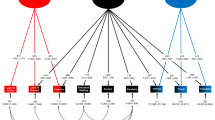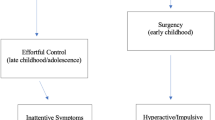Abstract
Impulsivity is a multifaceted personality construct that plays an important role throughout the lifespan in psychopathological disorders involving self-regulated behaviors. Its genetic and environmental etiology, however, is not clearly understood during the important developmental period of adolescence. This study investigated the relative influence of genes and environment on self-reported impulsive traits in adolescent twins measured on two separate occasions (waves) between the ages of 11 and 16. An adolescent version of the Barratt Impulsiveness Scale (BIS) developed for this study was factored into subscales reflecting inattention, motor impulsivity, and non-planning. Genetic analyses of these BIS subscales showed moderate heritability, ranging from 33–56% at the early wave (age 11–13 years) and 19–44% at the later wave (age 14–16 years). Moreover, genetic influences explained half or more of the variance of a single latent factor common to these subscales within each wave. Genetic effects specific to each subscale also emerged as significant, with the exception of motor impulsivity. Shared twin environment was not significant for either the latent or specific impulsivity factors at either wave. Phenotypic correlations between waves ranged from r = 0.25 to 0.42 for subscales. The stability correlation between the two latent impulsivity factors was r = 0.43, of which 76% was attributable to shared genetic effects, suggesting strong genetic continuity from mid to late adolescence. These results contribute to our understanding of the nature of impulsivity by demonstrating both multidimensionality and genetic specificity to different facets of this complex construct, as well as highlighting the importance of stable genetic influences across adolescence.

Similar content being viewed by others
References
Akaike AC (1987) Factor analysis and AIC. Psychometrika 52:317–332
American Psychiatric Association (1994) Diagnostic and statistical manual of mental disorders, 4th edn. Washington, DC
Baker LA, Barton M, Lozano DI, Raine A, Fowler JH (2006) The Southern California twin register at the University of Southern California: II. Twin Res Hum Genet 9:933–940
Baker LA, Jacobson KC, Raine A, Lozano DI, Bezdjian S (2007) Genetic and environmental bases of childhood antisocial behavior: a multi-informant twin study. J Abnorm Psychol 116:219–235
Barratt ES (1959) Anxiety and impulsiveness related to psychomotor efficiency. Percept Mot Skills 9:191–198
Bezdjian S, Baker LA, Tuvblad C (2011a) Genetic and environmental influences on impulsivity: a meta-analysis of twin, family and adoption studies. Clin Psychol Rev 31((7):1209–1223
Bezdjian S, Tuvblad C, Wyner JD, Raine A, & Baker LA (2011b) Motor impulsivity during childhood and adolescence: a longitudinal biometric analysis of the Go/NoGo task in twins aged 9-16 years old (under review)
Buss AH, Plomin R (1975) A temperament theory of personality development. Wiley, New York
Casey BJ, Davidson M, Rosen B (2002) Functional magnetic resonance imaging: basic principles of and applications to developmental science. Dev Sci 5:301–309
Casey BJ, Getz S, Galvan A (2008) The adolescent brain. Dev Rev 28:62–77
Caspi A, Silva PA (1995) Temperamental qualities at age three predict personality traits in young adulthood: Longitudinal evidence from a birth cohort. Child Dev 66:486–498
Coccaro EF (1989) Central serotonin and impulsive aggression. Br J Psychiatry 155:52–62
Coccaro EF, Bergeman CS, McClearn GE (1993) Heritability of irritable impulsiveness: a study of twins reared together and apart. Psychiatry Res 4:229–242
d’Acremont M, Van der Linder M (2005) Adolescent impulsivity: findings from a community sample. J Youth Adolesc 34:427–435
De Fruyt F, Mervielde I, Hoekstra HA, Rolland J (2000) Assessing adolescents’ personality with the NEO PI-R. Assessment 7:329–345
Eaves LJ, Martin NG, Eysenck SB (1977) An application of the analysis of covariance structures to the psychogenetical study of impulsiveness. Br J Math Stat Psychol 30:185–197
Eysenck SB, Eysenck HJ (1977) The place of impulsiveness in a dimensional system of personality description. Br J Soc Clin Psychol 16:57–68
Fossati A, Di Ceglie A, Acquarini E, Barratt ES (2002) Psychometric properties of an adolescent version of the Barratt Impulsiveness Scale-11 for a sample of Italian high school students. Percept Mot Skills 9:621–635
Fossati A, Feeney JA, Carretta I et al (2005) Modeling the relationships between adult attachment patterns and borderline personality disorder: the role of impulsivity and aggressiveness. J Soc Clin Psychol 24:520–537
Galvan A, Hare T, Voss H, Glover G, Casey BJ (2007) Risk-taking and the adolescent brain: who is at risk? Dev Sci 10:F8–F14
Hu L, Bentler PM (1998) Fit indices in covariance structure modeling: sensitivity to underparameterized model misspecification. Psychol Methods 3:424–453
Hur Y (2007) Evidence for non-additive genetic effects on Eysenck personality scales in South Korean twins. Twin Res Hum Genet 10:373–378
Irwin CE Jr (1989) Risk taking behaviors in the adolescent patient: are they impulsive? Pediatric Annals 18:122–133
Jang KL (2005) The behavioral genetics of psychopathology. Lawrence Erlbaum Associates, Mawah
Jensen PS, Youngstrom EA, Steiner H et al (2007) Consensus report on impulsive aggression as a symptom across diagnostic categories in child psychiatry: implications for medication studies. J Am Acad Child Adoles Psychiatry 4:309–322
Kenemans JL, Bekker EM, Lijffijt M, Overtoom CCE, Jonkman LM, Verbaten MN (2005) Attention deficit and impulsivity: selecting, shifting and stopping. Int J Psychophysiol 58:59–70
Klinteberg BA, Magnusson D, Schalling D (1989) Hyperactive behavior in childhood and adult impulsivity: a longitudinal study of male subjects. J Pers Individ Differ 1:43–50
Krueger RF, Moffitt TE, Caspi A, Bleske A, Silva PA (1998) Assortative mating for antisocial behavior: developmental and methodological implications. Behav Genet 28:173–186
Larsson H, Andershed H, Lichtenstein P (2006) A genetic factor explains most of the variation in the psychopathic personality. J Abnorm Psychol 155:221–230
Lykken DT (1978) The diagnosis of zygosity in twins. Behav Genet 8:437–473
McCrae RR, Costa PJ, Terracciano A, Parker WD, Mills CJ, De Fruyt F et al (2002) Personality trait development from age 12 to age 18: longitudinal, cross-sectional, and cross-cultural analyses. J Pers Soc Psychol 83:1456–1468
Moeller FG, Barratt ES, Dougherty DM, Schmitz JM, Swann AC (2001) Psychiatric aspects of impulsivity. Am J Psychiatry 158:1783–1793
Muthen LK, Muthen B (2006) Mplus: the comprehensive modeling program for applied researchers. Muthen & Muthen, Los Angeles
Neale MC, Cardon LR (1992) Methodology for genetic studies of twins and families. Kluwer Academic Publications, Dordrecht
Neale MC, Boker SM, Xie G, Maes H (2003) Mx: statistical modeling. Department of Psychiatry, Medical College of Virginia, Richmond
Olson SL, Schilling EM, Bates JE (1999) Measurements of impulsivity: construct coherence, longitudinal stability, and relationship with externalizing problems in middle childhood and adolescence. J Abnorm Child Psychol 27:151–165
Patton JH, Stanford MS, and Barratt ES, (1995) Factor structure of the barratt impulsiveness scale
Pedersen NL, Plomin R, McClearn GE, Friberg L (1988) Neuroticism, extroversion and related traits in adult twins reared apart and reared together. J Pers Soc Psychol 55:950–957
Plomin R, DeFries JC, McClearn GE, McGuffin P (2001) Behavioral genetics. Worth Publisher, United States of America
Raftery AE (1995) Bayesian model selection in social research. Sociol Methodol 25:111–163
Raine AD, Dodge K, Loeber R, Gatzke-Kopp L, Lynam D, Reynolds C, Stouthamer-Loeber M, Liu J (2006) The reactive-proactive aggression questionnaire: differential correlates of reactive and proactive aggression in adolescent boys. Aggress Behav 32:159–171
Reynolds B, Ortengren A, Richards JB, de Wit H (2006) Dimensions of impulsive behavior: personality and behavioral measures. Pers Individ Differ 40:305–315
Rhee SH, Waldman ID (2002) Genetic and environmental influences on antisocial behavior: a meta-analysis of twin and adoption studies. Psychol Bull 128:490–529
Saklofske DH, Eysenck SB (1983) Impulsiveness and venturesomeness in Canadian children. Psychol Rep 52:147–152
Seroczynski AD, Bergeman CS, Coccaro EF (1999) Etiology of impulsivity/aggression relationship: genes or environment? Psychiatry Res 86:41–57
Silverman IW (2003) Gender differences in delay of gratification: a meta-analysis. Sex Roles 49:451–463
Spear LP (2000) The adolescent brain and age-related behavioral manifestations. Neurosci Biobehav Rev 24:417–463
Trimpop RM, Kerr JH, Kirkcaldy B (1999) Comparing personality constructs of risk-taking behavior. J Personality Individ Differ 26:237–254
Tucker LR, Lewis C (1973) A reliability coefficient for maximum likelihood factor analysis. Psychometrika 38:1–10
Van den Oord EJ, Simonoff E, Eaves L, Pickles A, Silberg J, Maes H (2000) An evaluation of different approaches for behavior genetic analyses with psychiatric symptom scores. Behav Genet 30:1–18
Verdejo-Garcia A, Bechara A, Recknor EC, Perez-Garcia M (2007) Negative emotion-driven impulsivity predicts substance dependence problems. Drug Alcohol Depend 91:213–219
White JL, Moffitt TE, Caspi A, Bartusch DJ, Needles DJ, Stouthamer-Loeber M (1994) Measuring impulsivity and examining its relationship to delinquency. J Abnorm Psychol 103:192–205
Whiteside SP, Lynam DR (2001) The five factor model and impulsivity: using a structural model of personality to understand impulsivity. Pers Individ Differ 30:669–689
Acknowledgments
This study was funded by a grant from NIMH (R01 MH58354) awarded to Laura Baker. Adrian Raine was supported by NIMH (Independent Scientist Award K02 MH01114-08). We thank the Southern California Twin Project staff for data collection, and the participating families for their cooperation.
Author information
Authors and Affiliations
Corresponding author
Additional information
Edited by Irwin Waldman.
Rights and permissions
About this article
Cite this article
Niv, S., Tuvblad, C., Raine, A. et al. Heritability and Longitudinal Stability of Impulsivity in Adolescence. Behav Genet 42, 378–392 (2012). https://doi.org/10.1007/s10519-011-9518-6
Received:
Accepted:
Published:
Issue Date:
DOI: https://doi.org/10.1007/s10519-011-9518-6




